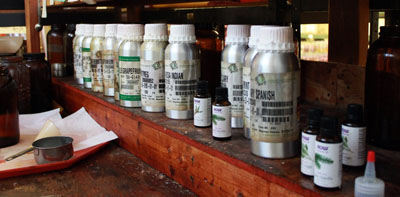A Blend of Oils
- Published in Resources
- A question was posed to us at Coventry about how we blend our fragrances. This is a twofold matter: how we create fragrances, and how they are delivered for our enjoyment. Fragrances are volatile, which means that they evaporate constantly into the air and make themselves available to us all day long. The blend has layers and each layer helps us experience the fragrance both as a whole and as parts. If you pay attention, you can experience the fragrance blends several different ways at different times.
 We smell the top note first, because that is the part of the fragrance blend that is released first. Top notes are energetic and fleeting. They last just a few minutes before receding and blending with the second layer (or the “heart note”). Top notes are the personality of the blend. Additionally, the top note is often called the “wake-up” scent because it uplifts and helps us feel alert. The list of top note oils is long. Some of our favorites are florals (geranium, gardenia and chamomile); spices (cinnamon and clove); citrus (lemon, bergamot, lime and tangerine); fruits (melon and raspberry); and greens scents (lavender, rosemary, and sage).
We smell the top note first, because that is the part of the fragrance blend that is released first. Top notes are energetic and fleeting. They last just a few minutes before receding and blending with the second layer (or the “heart note”). Top notes are the personality of the blend. Additionally, the top note is often called the “wake-up” scent because it uplifts and helps us feel alert. The list of top note oils is long. Some of our favorites are florals (geranium, gardenia and chamomile); spices (cinnamon and clove); citrus (lemon, bergamot, lime and tangerine); fruits (melon and raspberry); and greens scents (lavender, rosemary, and sage).
Slinking up behind the top note is the heart note. It takes its time coming to full bloom—almost ten minutes—but lasts for hours. Its job is to support and balance the base note and keep the personality of the fragrance (top note) stable. We respond to heart notes emotionally because they calm and center us. They are feel-good scents and that is why we call them heart notes. They are all from the floral family and some of our favorites are carnation, jasmine, orange blossom, peony, rose, ylang ylang, and tuberose.
The base note acts as a bridge for the top and heart notes. It bonds the entire fragrance together and gives it depth. Like music, a base note is needed to carry the song. The base note oils prolong our experience of the fragrance. We feel grounded and relaxed when we smell them. This is why we make sure there are base notes in all our blends. Our spiritual connections really rely on us being relaxed and in our bodies. Some of our favorite base notes are balsam, benzoin, cedarwood, frankincense, myrrh, patchouli, sandalwood, vanilla and vetiver.
The perfumer’s job is to create a scent that blends the top, middle, and base notes so they complement each other and work together. When one note is overpowering, the blend feels out of balance and does not give us that rich, multi-dimensional sensory experience.
Next time you smell a candle, see if you can pick out the top, middle, and base notes. Like tasting fine wine, savor the scent at the back of your throat and wait for the different scents make themselves known. This is practice also reduces stress, because you are slowing down and letting the world fall away as you focus on the overall blend, and then each layer of the scent. Happy sniffing!